
Manchukuo was a puppet state of the Empire of Japan in Northeast China that existed from 1932 until its dissolution in 1945. It was ostensibly founded as a republic, its territory consisting of the lands seized in the Japanese invasion of Manchuria; it was later declared to be a constitutional monarchy in 1934, though very little changed in the actual functioning of government. Manchukuo received limited diplomatic recognition, mostly from states aligned with the Axis powers, with its existence widely seen as illegitimate.
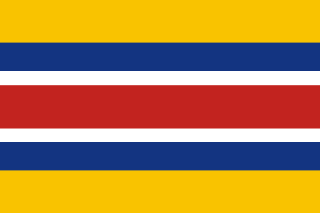
Mengjiang, also known as Mengkiang, officially the Mengjiang United Autonomous Government, was an autonomous zone in Inner Mongolia, formed in 1939 as a puppet state of the Empire of Japan, then from 1940 being under the nominal sovereignty of the Reorganized National Government of the Republic of China. It consisted of the previously Chinese provinces of Chahar and Suiyuan, corresponding to the central part of modern Inner Mongolia. It has also been called Mongukuo or Mengguguo. The capital was Kalgan, from where it was under the nominal rule of Mongol nobleman Demchugdongrub. The territory returned to Chinese control after the defeat of the Japanese Empire in 1945.

The South Manchuria Railway, officially The South Manchuria Railway Company, Ltd., Mantetsu or Mantie for short, was a large National Policy Company of the Empire of Japan whose primary function was the operation of railways on the Dalian–Fengtian (Mukden)–Changchun corridor in northeastern China, as well as on several branch lines.

The Soviet invasion of Manchuria, formally known as the Manchurian Strategic Offensive Operation or simply the Manchurian Operation, began on 9 August 1945 with the Soviet invasion of the Japanese puppet state of Manchukuo. It was the largest campaign of the 1945 Soviet–Japanese War, which resumed hostilities between the Union of Soviet Socialist Republics and the Empire of Japan after almost six years of peace.
This article is concerned with the events that preceded World War II in Asia.

Manchuria Aviation Company was the national airline of Manchukuo.

The Shōwa Steel Works was a Japanese government-sponsored steel mill that was one of the showpieces of the industrialization program for Manchukuo in the late 1930s.
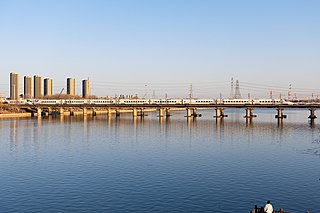
The Beijing–Harbin railway, or the Jingha Railway, is the railway that connects Beijing with Harbin, the capital of Heilongjiang Province. It spans 1,249 km (776 mi). It is a very prominent route in the provinces of northeastern China.

The Soviet–Japanese War, known in Mongolia as the Liberation War of 1945, was a campaign of the Second World War that began with the Soviet invasion of Japanese-controlled Manchukuo following the Soviet declaration of war against Japan on 9 August 1945. The Soviet Union and Mongolian People's Republic toppled the Japanese puppet states of Manchukuo in Manchuria and Mengjiang in Inner Mongolia, as well as northern Korea, Karafuto on the island of Sakhalin, and the Kuril Islands. The defeat of Japan's Kwantung Army helped bring about the Japanese surrender and the end of World War II. The Soviet entry into the war was a significant factor in the Japanese government's decision to surrender unconditionally, as it was made apparent that the Soviet Union was not willing to act as a third party in negotiating an end to hostilities on conditional terms.

The Manchukuo Imperial Army was the ground force of the military of the Manchukuo, a puppet state established by Imperial Japan in Manchuria, a region of northeastern China. The force was primarily used for fighting against Communist and Nationalist guerrillas in Manchukuo but also took part in battle against the Soviet Red Army on several occasions. It initially consisted of former National Revolutionary Army troops of the "Young Marshal" Zhang Xueliang who were recruited after the Japanese invasion of Manchuria en masse, but eventually expanded to include new volunteers and conscripts. The Imperial Army increased in size from about 111,000 troops in 1933 to an estimated strength of between 170,000 and 220,000 soldiers at its peak in 1945, being composed of Han Chinese, Manchus, Mongols, Koreans, Japanese, and White Russians. Throughout its existence the majority of its troops were considered to be mostly unreliable by their Japanese officers and advisers, due to poor training and low morale.

The Pacification of Manchukuo was a Japanese counterinsurgency campaign to suppress any armed resistance to the newly established puppet state of Manchukuo from various anti-Japanese volunteer armies in occupied Manchuria and later the Communist Northeast Anti-Japanese United Army. The operations were carried out by the Imperial Japanese Kwantung Army and the collaborationist forces of the Manchukuo government from March 1932 until 1942, and resulted in a Japanese victory.

Zang Shiyi was a Chinese general and Governor of Liaoning Province at the time of the invasion of Manchuria in 1932.
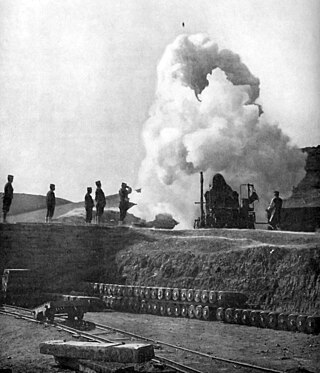
The Japanese 3rd Army was an army of the Imperial Japanese Army based in Manchukuo as a garrison force under the overall command of the Kwantung Army during World War II, but its history dates to the Russo-Japanese War.
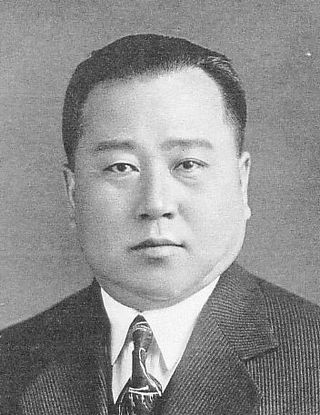
Lu Ronghuan, was a politician in the early Republic of China who subsequently served in a number of Cabinet posts of the Empire of Manchukuo.
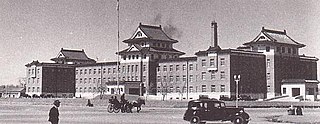
The Kwantung Army was a general army of the Imperial Japanese Army from 1919 to 1945.

Binjiang Province was one of the provinces of Manchukuo. Binjiang was founded on December 1, 1934 and was dissolved in August 1945. Binjiang had a mix of Chinese, Korean, Japanese, and Russian people. Binjiang was created when the old Jilin Province was split into the Binjiang Province and Jiandao Province, and Jilin Province. In 1937 Binjiang Province was split into the Binjiang Province and Mudanjiang Province.
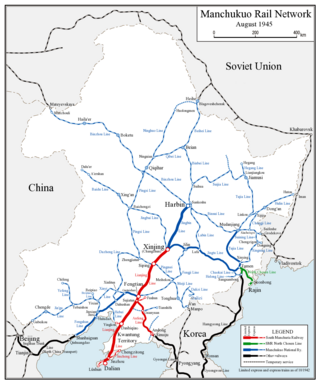
The Manchukuo National Railway was the state-owned national railway company of Manchukuo. Generally called the "國線", it was controlled by the Manchukuo Ministry of Transportation and had its lines primarily in the central and northern parts of the country. In local newspapers it was simply referred to as "國鉄". It was built, operated and managed by the South Manchuria Railway, a state-owned national railway company of the Empire of Japan, of which the Kwantung Army frequently intervened in its affairs.

The Renkyō Line was the primary trunk line of the South Manchuria Railway from 1907 to 1945. The 701.4 km (435.8 mi) line ran between Dalian (Dairen) and Changchun (Xinjing).
The Manchukuo Police was the main law enforcement agency of Manchukuo in what is today China.
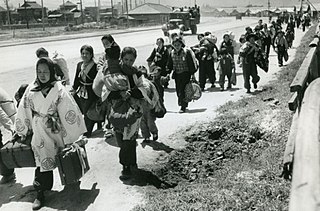
The Japanese settlers in Manchuria were the Japanese immigrants who came to Manchuria after the Russo-Japanese War and settled in zones of Japanese interests.


















